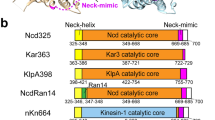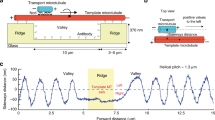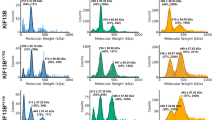Abstract
Kinesins are microtubule-based motor proteins that power intracellular transport1,2. Most kinesin motors, exemplified by Kinesin-1, move towards the microtubule plus end, and the structural changes that govern this directional preference have been described3,4,5. By contrast, the nature and timing of the structural changes underlying the minus-end-directed motility of Kinesin-14 motors (such as Drosophila Ncd6,7) are less well understood. Using cryo-electron microscopy, here we demonstrate that a coiled-coil mechanical element of microtubule-bound Ncd rotates ∼70° towards the minus end upon ATP binding. Extending or shortening this coiled coil increases or decreases velocity, respectively, without affecting ATPase activity. An unusual Ncd mutant that lacks directional preference8 shows unstable nucleotide-dependent conformations of its coiled coil, underscoring the role of this mechanical element in motility. These results show that the force-producing conformational change in Ncd occurs on ATP binding, as in other kinesins, but involves the swing of a lever-arm mechanical element similar to that described for myosins.
This is a preview of subscription content, access via your institution
Access options
Subscribe to this journal
Receive 51 print issues and online access
$199.00 per year
only $3.90 per issue
Buy this article
- Purchase on Springer Link
- Instant access to full article PDF
Prices may be subject to local taxes which are calculated during checkout



Similar content being viewed by others
References
Hirokawa, N. & Takemura, R. Kinesin superfamily proteins and their various functions and dynamics. Exp. Cell Res. 301, 50–59 (2004)
Sharp, D. J., Rogers, G. C. & Scholey, J. M. Microtubule motors in mitosis. Nature 407, 41–47 (2000)
Rice, S. et al. A structural change in the kinesin motor protein that drives motility. Nature 402, 778–784 (1999)
Asbury, C. L., Fehr, A. N. & Block, S. M. Kinesin moves by an asymmetric hand-over-hand mechanism. Science 302, 2130–2134 (2003)
Yildiz, A., Tomishige, M., Vale, R. D. & Selvin, P. R. Kinesin walks hand-over-hand. Science 303, 676–678 (2004)
McDonald, H. B., Stewart, R. J. & Goldstein, L. S. The kinesin-like ncd protein of Drosophila is a minus end-directed microtubule motor. Cell 63, 1159–1165 (1990)
Endow, S. A., Henikoff, S. & Soler-Niedziela, L. Mediation of meiotic and early mitotic chromosome segregation in Drosophila by a protein related to kinesin. Nature 345, 81–83 (1990)
Endow, S. A. & Higuchi, H. A mutant of the motor protein kinesin that moves in both directions on microtubules. Nature 406, 913–916 (2000)
Sablin, E. P. et al. Direction determination in the minus-end-directed kinesin motor ncd. Nature 395, 813–816 (1998)
Yun, M. et al. Rotation of the stalk/neck and one head in a new crystal structure of the kinesin motor protein, Ncd. EMBO J. 22, 5382–5389 (2003)
Kozielski, F., De Bonis, S., Burmeister, W. P., Cohen-Addad, C. & Wade, R. H. The crystal structure of the minus-end-directed microtubule motor protein ncd reveals variable dimer conformations. Struct. Fold. Des. 7, 1407–1416 (1999)
Endow, S. A. & Waligora, K. W. Determinants of kinesin motor polarity. Science 281, 1200–1202 (1998)
Wendt, T. G. et al. Microscopic evidence for a minus-end-directed power stroke in the kinesin motor ncd. EMBO J. 21, 5969–5978 (2002)
Hirose, K., Lockhart, A., Cross, R. A. & Amos, L. A. Three-dimensional cryoelectron microscopy of dimeric kinesin and ncd motor domains on microtubules. Proc. Natl Acad. Sci. USA 93, 9539–9544 (1996)
Sosa, H. et al. A model for the microtubule–Ncd motor protein complex obtained by cryo-electron microscopy and image analysis. Cell 90, 217–224 (1997)
Arnal, I., Metoz, F., DeBonis, S. & Wade, R. H. Three-dimensional structure of functional motor proteins on microtubules. Curr. Biol. 6, 1265–1270 (1996)
Woehlke, G. et al. Microtubule interaction site of the kinesin motor. Cell 90, 207–216 (1997)
Uyeda, T. Q., Abramson, P. D. & Spudich, J. A. The neck region of the myosin motor domain acts as a lever arm to generate movement. Proc. Natl Acad. Sci. USA 93, 4459–4464 (1996)
Stewart, R. J., Thaler, J. P. & Goldstein, L. S. Direction of microtubule movement is an intrinsic property of the motor domains of kinesin heavy chain and Drosophila ncd protein. Proc. Natl Acad. Sci. USA 90, 5209–5213 (1993)
Barrett, J. G., Manning, B. D. & Snyder, M. The Kar3p kinesin-related protein forms a novel heterodimeric structure with its associated protein Cik1p. Mol. Biol. Cell 11, 2373–2385 (2000)
Sproul, L. R., Anderson, D. J., Mackey, A. T., Saunders, W. S. & Gilbert, S. P. Cik1 targets the minus-end kinesin depolymerase kar3 to microtubule plus ends. Curr. Biol. 15, 1420–1427 (2005)
Chu, H. M. et al. Kar3 interaction with Cik1 alters motor structure and function. EMBO J. 24, 3214–3223 (2005)
Lockhart, A. & Cross, R. A. Origins of reversed directionality in the ncd molecular motor. EMBO J. 13, 751–757 (1994)
Pechatnikova, E. & Taylor, E. W. Kinetic mechanism of monomeric non-claret disjunctional protein (Ncd) ATPase. J. Biol. Chem. 272, 30735–30740 (1997)
Foster, K. A., Correia, J. J. & Gilbert, S. P. Equilibrium binding studies of non-claret disjunctional protein (Ncd) reveal cooperative interactions between the motor domains. J. Biol. Chem. 273, 35307–35318 (1998)
Menetrey, J. et al. The structure of the myosin VI motor reveals the mechanism of directionality reversal. Nature 435, 779–785 (2005)
deCastro, M. J., Fondecave, R. M., Clarke, L. A., Schmidt, C. F. & Stewart, R. J. Working strokes by single molecules of the kinesin-related microtubule motor ncd. Nature Cell Biol. 2, 724–729 (2000)
Pechatnikova, E. & Taylor, E. W. Kinetics processivity and the direction of motion of Ncd. Biophys. J. 77, 1003–1016 (1999)
Sharp, D. J., Yu, K. R., Sisson, J. C., Sullivan, W. & Scholey, J. M. Antagonistic microtubule-sliding motors position mitotic centrosomes in Drosophila early embryos. Nature Cell Biol. 1, 51–54 (1999)
Case, R. B., Pierce, D. W., Hom-Booher, N., Hart, C. L. & Vale, R. D. The directional preference of kinesin motors is specified by an element outside of the motor catalytic domain. Cell 90, 959–966 (1997)
Acknowledgements
We thank S. Rice, J. Kardon and J. Ebstein for initial work on this project. This work was supported by NIH grants (to R.D.V. and R.A.M.). Some of the work presented here was conducted at the National Resource for Automated Molecular Microscopy, which is supported by the NIH.
Author information
Authors and Affiliations
Corresponding author
Ethics declarations
Competing interests
Reprints and permissions information is available at npg.nature.com/reprintsandpermissions. The authors declare no competing financial interests.
Supplementary information
Supplementary Figure Legends
Text to accompany Supplementary Figures 1–5 referred to in the text, with additional references. (DOC 39 kb)
Supplementary Figure 1
This figure demonstrates that the Ncd neck position is not determined by the apparent interaction between the tip of the neck and the adjacent motor domain. (JPG 174 kb)
Supplementary Figure 2
This figure demonstrates that the Ncd neck occupies a similar position in the AMPPNP and ADPAlF4- states. (JPG 175 kb)
Supplementary Figure 3
This figure shows microtubule binding interface implied by docking experiments are reasonable. (JPG 140 kb)
Supplementary Figure 4
Statistical different maps provide additional support for our model for the bidirectional motility of N340K, and demonstrate that the AMPPNP and ADP-ALF4- states for this mutant are the same. (JPG 196 kb)
Supplementary Figure 5
Gel Filtration results which confirm the appropriate size for the Ncd heterodimer and monomer. (PDF 220 kb)
Rights and permissions
About this article
Cite this article
Endres, N., Yoshioka, C., Milligan, R. et al. A lever-arm rotation drives motility of the minus-end-directed kinesin Ncd. Nature 439, 875–878 (2006). https://doi.org/10.1038/nature04320
Received:
Accepted:
Published:
Issue Date:
DOI: https://doi.org/10.1038/nature04320
This article is cited by
-
Anchoring geometry is a significant factor in determining the direction of kinesin-14 motility on microtubules
Scientific Reports (2022)
-
CYK4 relaxes the bias in the off-axis motion by MKLP1 kinesin-6
Communications Biology (2021)
-
Overview of the mechanism of cytoskeletal motors based on structure
Biophysical Reviews (2018)
-
The tetrameric kinesin Kif25 suppresses pre-mitotic centrosome separation to establish proper spindle orientation
Nature Cell Biology (2017)
-
The mitotic kinesin-14 KlpA contains a context-dependent directionality switch
Nature Communications (2017)
Comments
By submitting a comment you agree to abide by our Terms and Community Guidelines. If you find something abusive or that does not comply with our terms or guidelines please flag it as inappropriate.



